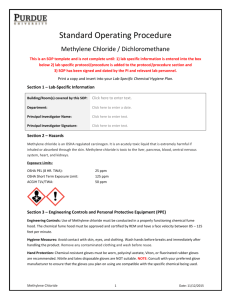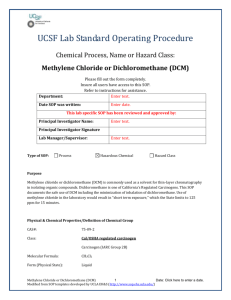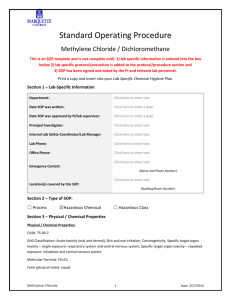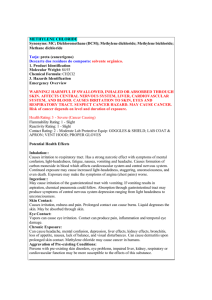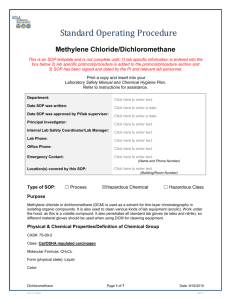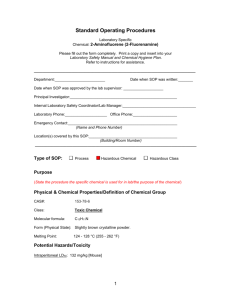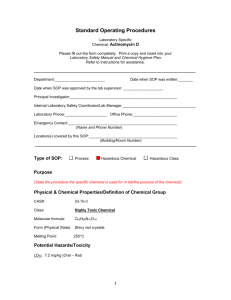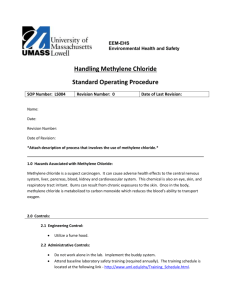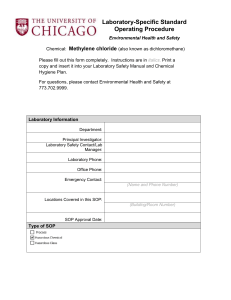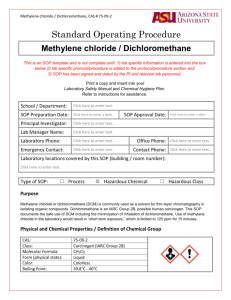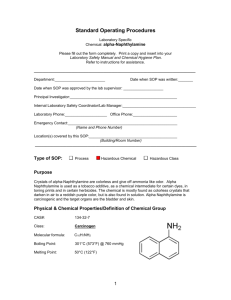UCLA - Environmental Health & Safety
advertisement
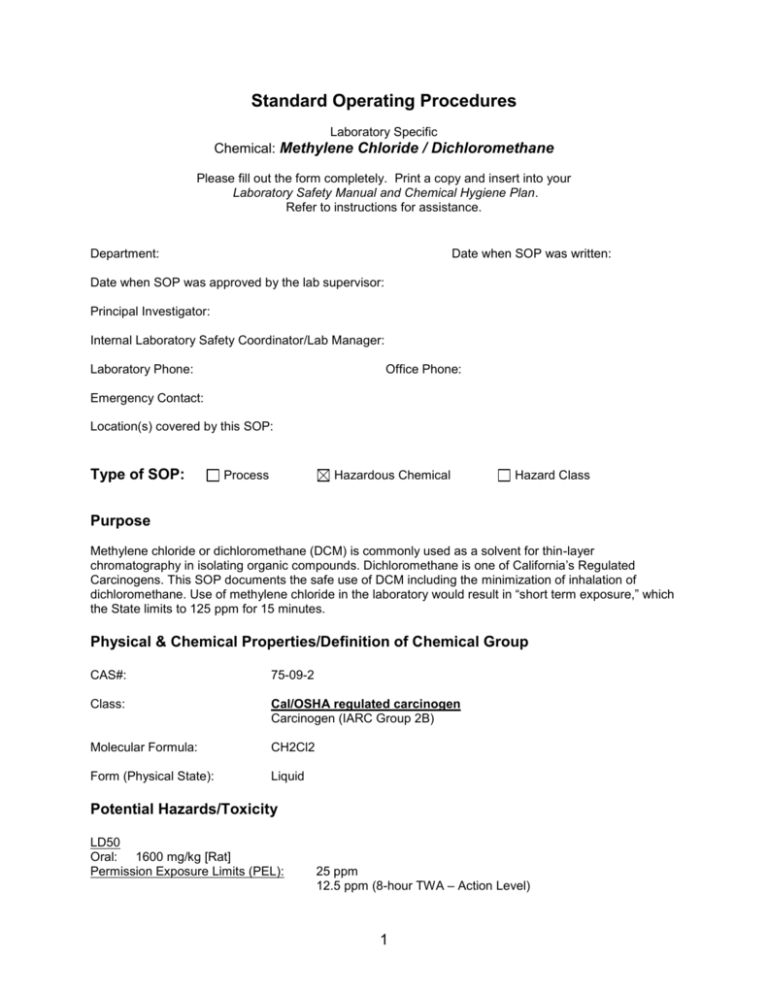
Standard Operating Procedures Laboratory Specific Chemical: Methylene Chloride / Dichloromethane Please fill out the form completely. Print a copy and insert into your Laboratory Safety Manual and Chemical Hygiene Plan. Refer to instructions for assistance. Department: Date when SOP was written: Date when SOP was approved by the lab supervisor: Principal Investigator: Internal Laboratory Safety Coordinator/Lab Manager: Laboratory Phone: Office Phone: Emergency Contact: Location(s) covered by this SOP: Type of SOP: Process Hazardous Chemical Hazard Class Purpose Methylene chloride or dichloromethane (DCM) is commonly used as a solvent for thin-layer chromatography in isolating organic compounds. Dichloromethane is one of California’s Regulated Carcinogens. This SOP documents the safe use of DCM including the minimization of inhalation of dichloromethane. Use of methylene chloride in the laboratory would result in “short term exposure,” which the State limits to 125 ppm for 15 minutes. Physical & Chemical Properties/Definition of Chemical Group CAS#: 75-09-2 Class: Cal/OSHA regulated carcinogen Carcinogen (IARC Group 2B) Molecular Formula: CH2Cl2 Form (Physical State): Liquid Potential Hazards/Toxicity LD50 Oral: 1600 mg/kg [Rat] Permission Exposure Limits (PEL): 25 ppm 12.5 ppm (8-hour TWA – Action Level) 1 Acute Effects Very hazardous in case of eye contact (irritant), of ingestion, of inhalation. In case of ingestion, DCM may cause irritation of the gastrointestinal tract with vomiting. If vomiting results in aspiration, chemical pneumonia could follow. Absorption through gastrointestinal tract may produce symptoms of central nervous system depression ranging from light headedness to unconsciousness. Hazardous in case of skin contact (irritant, permeator). Inflammation of the eye is characterized by redness, watering, and itching. Eye contact may cause temporal eye damage. Chronic Effects Can cause headache, mental confusion, depression, liver effects, kidney effects, bronchitis, loss of appetite, nausea, lack of balance, and visual disturbances. Can cause dermatitis upon prolonged skin contact. Mutagenic Effects Methylene chloride may cause cancer in humans. Developmental Toxicity The substance is toxic to lungs, the nervous system, liver, mucous membrane Personal Protective Equipment (PPE) The level of skin and eye protection should be selected based on the potential for splashing and other forms of exposure. Minimum potential for splash & exposure: Single pair of chemical resistant gloves Protective clothing (e.g. non-porous lab coat, impervious sleeves; closed-toed impervious shoes) When using or transferring large quantities (>1 L): Single pair of chemical resistant gloves o Immediately replace with new gloves when splash occurs. Chemical resistant lab coat o Avoid using the traditional cotton-polyester white lab coat, which readily collects/absorbs compounds. Protective clothing (e.g. non-porous sleeves, closed-toed impervious footwear) Engineering Controls All operations involving methylene chloride and dilutions should be carried out in a certified chemical fume hood or a ducted Biosafety cabinet to keep airborne level below recommended exposure limits Chemical fume hoods used as containment areas for particularly hazardous chemicals must have a face velocity of 100 cfm, averaged over the face of the hood and must be certified annually. Laboratory rooms must be at negative pressure with respect to the corridors and external environment. The laboratory/room door must be kept closed at all times. 2 Vacuum lines are to be protected by HEPA (high efficiency particulate air) filters or higher efficiency scrubbers. First Aid Procedures Skin & Eye Exposure: Minor skin contact requires washing with soap and water. Soaking or flushing contaminated areas of the skin with water for periods up to 15 minutes is required if a large area comes into contact with the chemical, or if prolonged contact occurs. Contaminated clothing may hold the chemicals in contact with the skin without being immediately noticed. In the event of eye contact, the eye should be immediately be flushed with water. If the chemical is very irritating, it is likely that the affected individual will require assistance to hold the eye open during the flushing. Ingestion: DO NOT induce vomiting, give milk or water if conscious, and get medical attention immediately. Inhalation: Remove rapidly to clean air. Administer rescue breathing if necessary and call emergency services. Seek medical attention if needed. Special Handling and Storage Requirements Keep in a tightly closed container, stored in a cool, dry, ventilated area. Protect against physical damage. Isolate from any source of heat or ignition. Store in secondary containment, isolate from other chemical compounds with proper labeling: REGULATED CARCINOGEN DCM can be stored in the same cabinet as other regulated carcinogen Segregate the chemicals from incompatible materials, as described in the UCLA Safety Manual and Chemical Hygiene Plan. Designated Areas Designated area(s) for use and storage of methylene chloride must be established. All chemicals containing methylene chloride must be secondarily contained with proper signage. Signage is required for the container, designated work area and storage location. Sign wording must state the following: “DANGER, CANCER HAZARD” Spill and Accident Procedure Chemical Spill Dial 911 and x59797 3 Spill – Help contaminated or injured persons. Evacuate the spill area. Avoid breathing vapors. Eliminate sources of ignition if the chemical is flammable. If possible, confine the spill to a small area using a spill kit or absorbent material. Keep others from entering contaminated area (e.g., use caution tape, barriers, etc.). Small (<1 L) – If you have training, you may assist in the clean-up effort. Use appropriate personal protective equipment and clean-up material for chemical spilled. Double bag spill waste in clear plastic bags, label and take to the next chemical waste pick-up. Large (>1 L) – Dial 911 (or 310-825-1491 from cell phone) and EH&S at x59797 for assistance. Chemical Spill on Body or Clothes – Remove clothing and rinse body thoroughly in emergency shower for at least 15 minutes. Seek medical attention. Notify supervisor and EH&S at x59797 immediately. Chemical Splash Into Eyes – Immediately rinse eyeball and inner surface of eyelid with water for 15 minutes by forcibly holding the eye open. Seek medical attention. Notify supervisor and EH&S at x59797 immediately. Medical Emergency Dial 911 or x52111 Life Threatening Emergency, After Hours, Weekends And Holidays – Dial 911 (or 310825-1491 from cell phone) or contact the Ronald Reagan UCLA Medical Center (emergency room) directly at x52111 (located at 757 Westwood Plaza, enter from Gayley Avenue). Note: All serious injuries must be reported to EH&S at x59797 within 8 hours. Non-Life Threatening Emergency– Go to the Occupational Health Facility (OHF), x56771, CHS room 67-120 (This is on the 6th floor, 7th corridor, room 120. Enter through the School of Dentistry on Tiverton Drive and proceed to the “O” elevator to the 6th floor.)Hours: M - F, 7:30 a.m. to 4:30 p.m. At all other times report to Ronald Regan UCLA Medical Center (emergency room) at x52111. Note: All serious injuries must be reported to EH&S at x59797 within 8 hours. Needle stick/puncture exposure (as applicable to chemical handling procedure) – Wash the affected area with antiseptic soap and warm water for 15 minutes. For mucous membrane exposure, flush the affected area for 15 minutes using an eyewash station. Page the needle stick nurse by dialing 231 from a campus phone, enter 93333 when prompted and then enter your extension. Hours: M – F, 8:00 a.m. to 4:00 p.m. At all other times report to Ronald Regan UCLA Medical Center (emergency room) at x52111. Note: All needle stick/puncture exposures must be reported to EH&S at x59797 within 8 hours. Decontamination/Waste Disposal Procedure No waste streams containing methylene chloride shall be disposed of in sinks. Decontaminate work space with 70-75% ethanol. Wash hands and arms with soap and water after finished. Contaminated pipet tips, eppendorf tubes, and gloves should be discarded as hazardous waste according to UCLA EH&S waste disposal procedures. Waste containers containing methylene chloride must be labeled: “DANGER, CANCER HAZARD” Material Safety Data Sheet (MSDS) Location (State the location of MSDS) 4 Hardcopy AND electronic copy MSDS from the same manufacturer must be available for Methylene Chloride. Online MSDS can be accessed at http://msds.ehs.ucla.edu. Protocol/Procedure (Add specific description of procedure) Any deviation from this SOP requires approval from PI. Documentation of Training (signature of all users is required) Prior to conducting any work with methylene chloride, designated personnel must provide training to his/her laboratory personnel specific to the hazards involved in working with this substance, work area decontamination, and emergency procedures. The Principal Investigator must provide his/her laboratory personnel with a copy of this SOP and a copy of the methylene chloride MSDS provided by the manufacturer. The Principal Investigator must ensure that his/her laboratory personnel have attended appropriate laboratory safety training or refresher training within the last two years. I have read and understand the content of this SOP: Name Signature Date ________________________________ ____________________________ ____________ ________________________________ ____________________________ ____________ ________________________________ ____________________________ ____________ ________________________________ ____________________________ ____________ ________________________________ ____________________________ ____________ ________________________________ ____________________________ ____________ ________________________________ ____________________________ ____________ ________________________________ ____________________________ ____________ ________________________________ ____________________________ ____________ ________________________________ ____________________________ ____________ ________________________________ ____________________________ ____________ ________________________________ ____________________________ ____________ ________________________________ ____________________________ ____________ 5 ________________________________ ____________________________ ____________ ________________________________ ____________________________ ____________ ________________________________ ____________________________ ____________ ________________________________ ____________________________ ____________ ________________________________ ____________________________ ____________ ________________________________ ____________________________ ____________ ________________________________ ____________________________ ____________ ________________________________ ____________________________ ____________ ________________________________ ____________________________ ____________ ________________________________ ____________________________ ____________ ________________________________ ____________________________ ____________ 6
